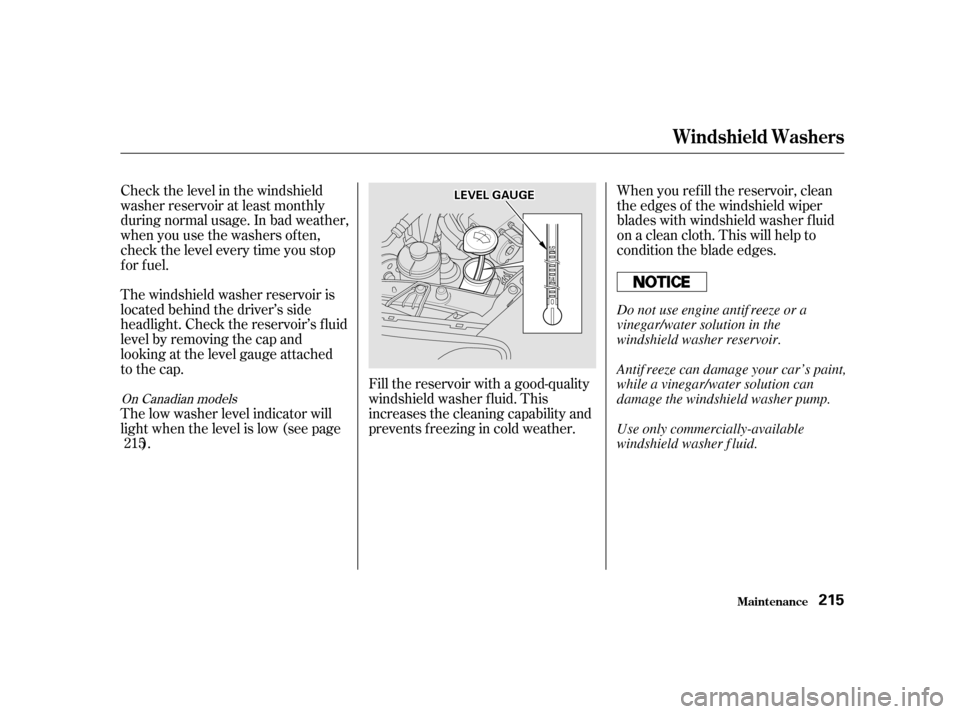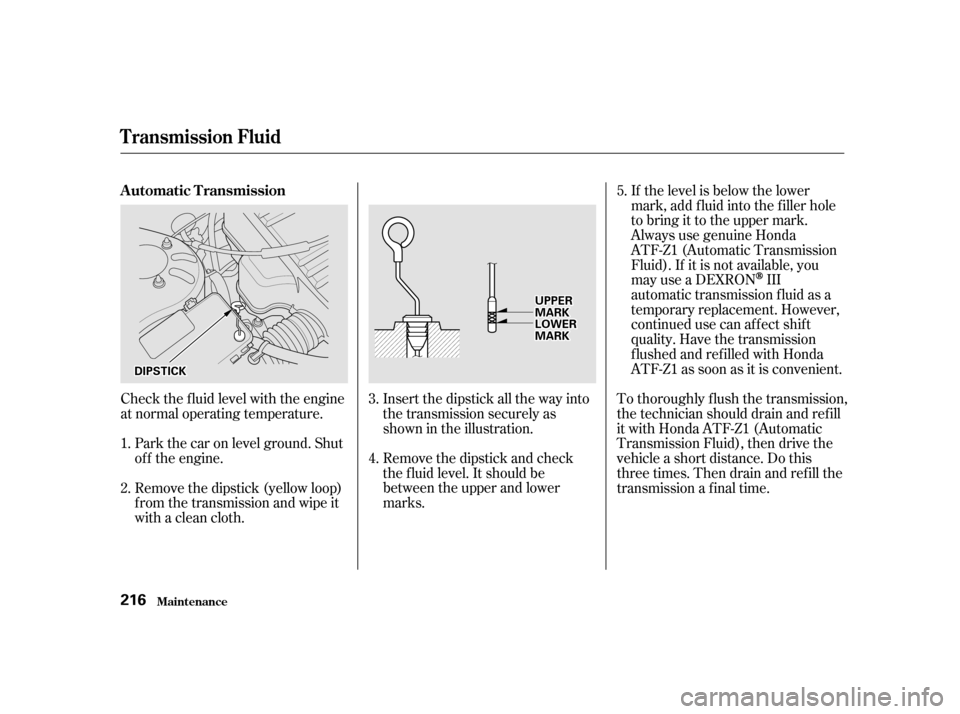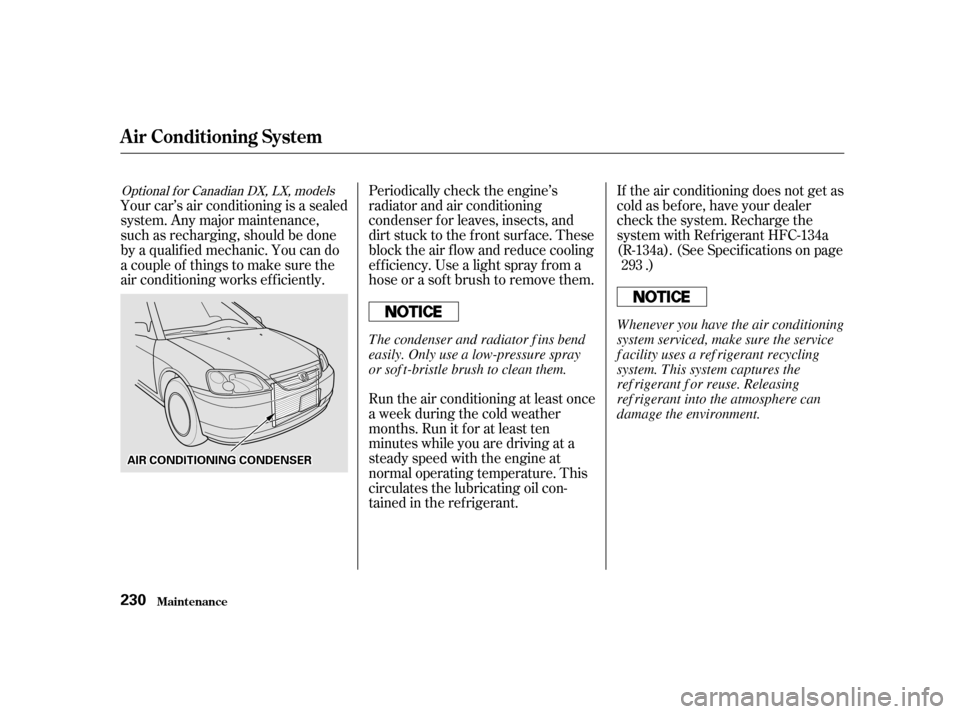Page 212 of 319
Tightening torque:
When the coolant stops draining,
tightenthedrainpluginthe
bottom of the radiator. Apply non-
hardening sealant to the drain bolt
threads, put a new washer on the
drain bolt, and reinstall the drain
bolt in the engine block. Tighten it
securely.
Pour Honda All Season
Antif reeze/Coolant Type 2 into
the radiator up to the base of the
f iller neck. This coolant is a
mixture of 50 percent antif reeze
and 50 percent water. Pre-mixing
is not required.The cooling system capacity is:
10.
11.
CONT INUED
With 5-speed manual transmission:With automatic transmission:
Cooling Syst em
Maint enance 213
FFIILLLLEERRNNEECCKK
FFiilllluuppttoohheerree
58 lbf·ft (78 N·m , 8.0 kgf·m) 1.06 US gal (4.0
, 0.88 Imp gal)
1.03 US gal (3.9
, 0.86 Imp gal)
Page 213 of 319
Start the engine and hold it at
1,500 rpm until the radiator f an
comes on. Turn of f the engine.
Check the coolant level in the
radiator and add coolant if needed.
Install the radiator cap, and
tighten it fully.
If necessary, f ill the reserve tank
to the MAX mark. Install the
reserve tank cap.
Start the engine and let it run until
the radiator fan comes on two
times. Then stop the engine.
Remove the radiator cap. Fill the
radiator with coolant up to the
base of the f iller neck.
Start the engine and let it run f or
about 30 seconds. Then turn of f
the engine.
Check the level in the radiator,
add coolant if needed.
Fill the reserve tank to the MAX
mark. Install the reserve tank cap.
Install the radiator cap, and
tighten it to the first stop.
16. 17. 18.
19. 20.
12.
13.
14. 15.
Cooling Syst em
Maint enance
214
Page 214 of 319

Check the level in the windshield
washer reservoir at least monthly
during normal usage. In bad weather,
when you use the washers of ten,
check the level every time you stop
for fuel.When you ref ill the reservoir, clean
the edges of the windshield wiper
blades with windshield washer fluid
on a clean cloth. This will help to
condition the blade edges.
The windshield washer reservoir is
located behind the driver’s side
headlight. Check the reservoir’s f luid
level by removing the cap and
looking at the level gauge attached
to the cap. Fill the reservoir with a good-quality
windshield washer f luid. This
increases the cleaning capability and
prevents f reezing in cold weather.
The low washer level indicator will
light when the level is low (see page
).
215
On Canadian models
Windshield Washers
Maint enance 215
LLEEVVEELLGGAAUUGGEE
Do not use engine antif reeze or a
vinegar/water solution in the
windshield washer reservoir.
Antif reeze can damage your car’s paint,
while a vinegar/water solution can
damage the windshield washer pump.
Use only commercially-available
windshield washer f luid.
Page 215 of 319

Insert the dipstick all the way into
the transmission securely as
shown in the illustration.
Remove the dipstick and check
the f luid level. It should be
between the upper and lower
marks.
Check the f luid level with the engine
at normal operating temperature.
Remove the dipstick (yellow loop)
f rom the transmission and wipe it
with a clean cloth.
Park the car on level ground. Shut
of f the engine. If the level is below the lower
mark, add f luid into the f iller hole
to bring it to the upper mark.
Always use genuine Honda
ATF-Z1 (Automatic Transmission
Fluid). If it is not available, you
may use a DEXRON
III
automatic transmission fluid as a
temporary replacement. However,
continued use can af f ect shif t
quality. Have the transmission
f lushed and ref illed with Honda
ATF-Z1 as soon as it is convenient.
To thoroughly f lush the transmission,
the technician should drain and ref ill
it with Honda ATF-Z1 (Automatic
Transmission Fluid), then drive the
vehicle a short distance. Do this
three times. Then drain and ref ill the
transmission a f inal time.
3. 4. 5.
1. 2.
Automatic Transmission
T ransmission Fluid
Maint enance
216
DDIIPPSSTTIICCKK
UUPPPPEERRMMAARRKKLLOOWWEERRMMAARRKK
Page 219 of 319
A low power steering f luid level can
indicate a leak in the system. Check
the f luid level f requently and have
the system inspected as soon as
possible.
Always use Honda Power Steering
Fluid. If it is not available, you may
use another power steering f luid as
an emergency replacement.
However, continued use can cause
increased wear and poor steering in
cold weather. Have the power
steering system f lushed and ref illed
with Honda PSF as soon as possible.
You should check the f luid level in
the power steering reservoir at least
once a year. Check the level when
the engine is cold. Look at the side
of the reservoir. The f luid should be
between the UPPER LEVEL and
LOWER LEVEL. If it is below the
LOWER LEVEL, add power steering
f luid to the UPPER LEVEL.
Power Steering
Maint enance
220
UUPPPPEERRLLEEVVEELL
LLOOWWEERRLLEEVVEELL T urning the steering wheel to f ull lef t
or right lock and holding it there can
damage the power steering pump.
Page 220 of 319
The air cleaner element should be
replaced according to the time and
distance recommendations in the
maintenance schedule.Caref ully clean the inside of the
air cleaner housing with a damp
rag.
Place the new air cleaner element
in the air cleaner housing.
The air cleaner element is inside the
air cleaner housing in the engine
compartment.
To replace it:Loosen the seven bolts and
remove the air cleaner housing
cover.
Remove the old air cleaner
element. Reinstall the air cleaner housing cover, tighten the seven bolts.
1.
3.
2. 4. 5.
Replacement
Maint enance
A ir Cleaner Element
221
AAIIRRCCLLEEAANNEERREELLEEMMEENNTT
BBOOLLTTSS
BBOOLLTTSS
Page 224 of 319
�´ �µ
Spark Plug Gap:
Push the wire connector onto the
ignition coil. Make sure it locks in
place.
Repeat this procedure f or the
other three spark plugs.
Reinstall the cover.
Install the ignition coil. Reinstall
the nut.
NGK:
DENSO:
8.
11.
10. 9.
Maint enance
Spark Plugs
Specif ications:
225
PZFR6F-11
PKJ20CR-M11
0.04 in (1.1 mm) 0
0.1 mm
Tighten the spark plugs caref ully. A
spark plug that is too loose can
overheat and damage the engine.
Overtightening can cause damage to
the threads in the cylinder head.
Page 229 of 319

Periodically check the engine’s
radiator and air conditioning
condenser f or leaves, insects, and
dirt stuck to the f ront surf ace. These
block the air f low and reduce cooling
ef f iciency. Use a light spray f rom a
hose or a sof t brush to remove them.If the air conditioning does not get as
cold as before, have your dealer
check the system. Recharge the
system with Ref rigerant HFC-134a
(R-134a). (See Specif ications on page
.)
Run the air conditioning at least once
a week during the cold weather
months. Run it f or at least ten
minutes while you are driving at a
steady speed with the engine at
normal operating temperature. This
circulates the lubricating oil con-
tained in the ref rigerant.
Your car’s air conditioning is a sealed
system. Any major maintenance,
such as recharging, should be done
by a qualif ied mechanic. You can do
a couple of things to make sure the
air conditioning works ef f iciently.
293Optional for Canadian DX, LX, models
A ir Condit ioning Syst em
Maint enance
230
AAIIRRCCOONNDDIITTIIOONNIINNGGCCOONNDDEENNSSEERR Whenever you have the air conditioning
system serviced, make sure the service
f acility uses a ref rigerant recycling
system. This system captures the
ref rigerant f or reuse. Releasing
ref rigerant into the atmosphere can
damage the environment.
The condenser and radiator f ins bend
easily. Only use a low-pressure spray
or sof t-bristle brush to clean them.